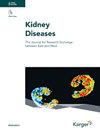罗沙司他治疗移植后贫血:综述
IF 3.1
4区 医学
Q1 UROLOGY & NEPHROLOGY
引用次数: 0
摘要
背景:缺氧诱导因子-脯氨酸羟化酶抑制剂(HIF-PHIs)是一种用于治疗肾性贫血的新型口服药物。Roxadustat是一种一流的HIF-PHI,用于治疗慢性肾病患者的贫血,已在中国、日本、韩国、智利和欧洲获得批准。罗沙司他参与HIF降解,可以刺激内源性促红细胞生成素(EPO)的产生,提高铁的利用率。此外,罗沙司他还能促进膳食铁的吸收和运输。与传统的促红细胞生成剂(ESA)治疗相比,它可能会降低心血管风险和死亡率,因为它只会引起血浆EPO水平的轻微升高。II期和III期临床试验报告显示,罗沙司他对治疗慢性肾脏疾病患者有效。由于慢性肾病患者与接受肾移植的患者不同,罗沙司他在肾移植受者(KTRs)中的作用需要进一步研究。摘要:临床试验表明,罗沙司他可通过刺激内源性EPO生成和优化铁利用,有效提高和维持透析依赖和非透析依赖慢性肾病患者的血红蛋白水平。罗沙司他最近被有效地用于治疗epo抵抗性贫血患者。它也被用于治疗移植后贫血(PTA)患者,这是铁缺乏和肾小球滤过率受损的肾移植受者死亡的预后因素。在这里,我们在一篇叙述性综述中考察了四项研究的发现,并讨论了我们对这一研究领域的看法。关键信息:罗沙司他可显著改善合并PTA的ktr患者的血红蛋白水平,但不影响肾功能。它还通过降低铁蛋白和hepcidin水平和增加总铁结合能力、转铁蛋白和血清铁水平来提高铁的利用。罗沙司他可改善贫血和炎症,并可能对ktr患者有肾保护作用。本文章由计算机程序翻译,如有差异,请以英文原文为准。
Roxadustat for Patients with Post-transplant Anemia: A Narrative Review
Background: Hypoxia-inducible factor-prolyl hydroxylase inhibitors (HIF-PHIs) are novel oral agents used for renal anemia treatment. Roxadustat, a first-in-class HIF-PHI used for treating anemia in chronic kidney disease patients, has been approved in China, Japan, South Korea, Chile, and Europe. Roxadustat is involved in HIF degradation, which can stimulate endogenous erythropoietin (EPO) production and improve iron utilization. Besides, roxadustat can promote dietary iron uptake and transport. In comparison with traditional erythropoiesis-stimulating agent (ESA) treatment, it might reduce cardiovascular risk and mortality as it causes only a slight increase in the plasma EPO level. Phase II and III clinical trial reports have shown that roxadustat is effective for treating chronic kidney disease patients. The role of roxadustat in kidney transplant recipients (KTRs) needs to be examined as patients with chronic kidney disease are different from those receiving renal transplants. Summary: Clinical trials have demonstrated that roxadustat effectively increases and maintains hemoglobin levels in patients with dialysis-dependent and non-dialysis-dependent chronic kidney disease by stimulating endogenous EPO production and optimizing iron utilization. Roxadustat has recently been used effectively to treat patients with EPO-resistant anemia. It has also been used for treating patients with post-transplant anemia (PTA), which is a prognostic factor for mortality in kidney transplant recipients with an iron deficiency and impaired glomerular filtration rate. Here, we examined the findings of four studies in a narrative review and discussed our perspectives regarding this field of study. Key Messages: Roxadustat significantly improves hemoglobin levels without affecting renal function in KTRs with PTA. It also enhances iron utilization by decreasing ferritin and hepcidin levels and increasing total iron binding capacity, transferrin, and serum iron levels. Roxadustat ameliorates anemia and inflammation, and might have reno-protective effects in KTRs.
求助全文
通过发布文献求助,成功后即可免费获取论文全文。
去求助
来源期刊

Kidney Diseases
UROLOGY & NEPHROLOGY-
CiteScore
6.00
自引率
2.70%
发文量
33
审稿时长
27 weeks
期刊介绍:
''Kidney Diseases'' aims to provide a platform for Asian and Western research to further and support communication and exchange of knowledge. Review articles cover the most recent clinical and basic science relevant to the entire field of nephrological disorders, including glomerular diseases, acute and chronic kidney injury, tubulo-interstitial disease, hypertension and metabolism-related disorders, end-stage renal disease, and genetic kidney disease. Special articles are prepared by two authors, one from East and one from West, which compare genetics, epidemiology, diagnosis methods, and treatment options of a disease.
 求助内容:
求助内容: 应助结果提醒方式:
应助结果提醒方式:


